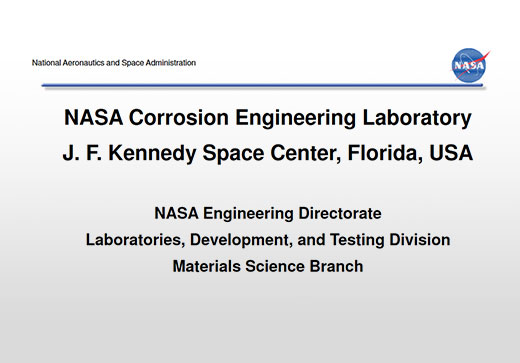Corrosion at KSC
The Corrosion Engineering Laboratory at the NASA J. F. Kennedy Space Center (KSC) is a network of people, equipment, and facilities that provide engineering services and technical innovations in all areas of corrosion for NASA and external customers.
The NASA KSC Corrosion Engineering Laboratory consists of a Beachside Atmospheric Corrosion Test Site, a Coatings Application Facility, and an Indoor Corrosion Laboratory. In addition, the Corrosion Engineering Laboratory works within the larger NASA Engineering Directorate to include other capabilities for performing both chemical and physical analysis on coatings and materials, non-destructive evaluation (NDE) methods, and testing, such as tensile, shock, and vibration.
The Corrosion Engineering Laboratory is a multiuser facility that serves NASA Centers, various DoD and Government Agencies, private companies, and educational institutions. The KSC Beachside Atmospheric Exposure Test Site is unique within the government, making it a valuable resource that is available to customers outside NASA.
Kennedy Space Center’s launch facilities are located within 1000 feet of the Atlantic Ocean. Salt from the ocean combined with the heavy lift launch vehicles’ acidic rocket exhaust make corrosion protection a high priority. For these reasons, KSC maintains state-of-the-art corrosion protection capabilities. Our Atmospheric Corrosion Test Site has been documented as having higher atmospheric corrosion rates than other known test sites in the United States.
Historical Overview
Corrosion control at NASA KSC began in the 1960s with the evaluation of long-term protective coatings for the atmospheric protection of carbon steel, which was and is still used for launch structures and ground support equipment (GSE) at NASA. The KSC Beachside Atmospheric Corrosion Test Site was created at that time. The site has provided over 50 years of information on the long-term performance of many different types of materials. Over the years, numerous material failures at KSC have been attributed to various forms of corrosion (atmospheric corrosion, stress corrosion cracking, pitting corrosion, crevice corrosion, intergranular corrosion, hydrogen embrittlement, corrosion fatigue, etc.). Materials testing and applied research is performed by engineers and technicians at the Corrosion Engineering Laboratory to identify solutions to resolve many of these material failure concerns



















